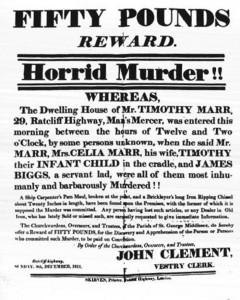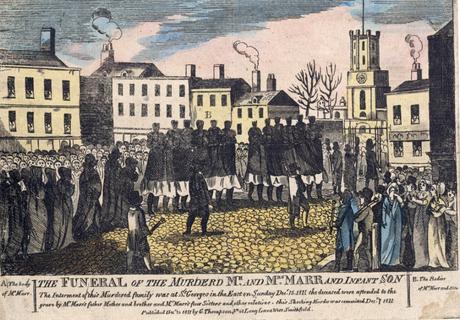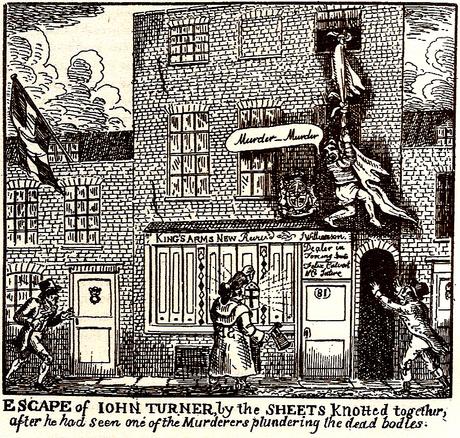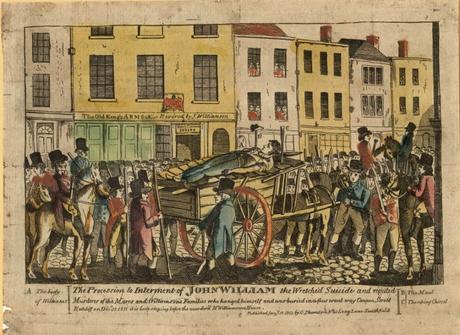 Welcome to British Isles Friday! British Isles Friday is a weekly event for sharing all things British and Irish - reviews, photos, opinions, trip reports, guides, links, resources, personal stories, interviews, and research posts. Join us each Friday to link your British and Irish themed content and to see what others have to share. The link list is at the bottom of this post. Pour a cup of tea or lift a pint and join our link party!
Welcome to British Isles Friday! British Isles Friday is a weekly event for sharing all things British and Irish - reviews, photos, opinions, trip reports, guides, links, resources, personal stories, interviews, and research posts. Join us each Friday to link your British and Irish themed content and to see what others have to share. The link list is at the bottom of this post. Pour a cup of tea or lift a pint and join our link party!
Last week, I learned a lot from the book The Art of English Murder by Lucy Worsley. Tina enjoyed a book that is set in Ireland during the time of COVID-19: 56 Days by Catherine Ryan Howard.
The book that I reviewed last week, The Art of the English Murder, began with the Ratcliffe Highway Murders. I wondered if there was still enough infrastructure present today for some fantasy travel, a walking tour of the sites related to this historic event.
 I've heard of the Ratcliffe Highway Murders, but I confused them in my mind with the term "highwaymen" and assumed it was a rural event of a robbery gone wrong. In fact, Ratcliffe Highway is an ancient road running east from the City of London since at least Saxon times and possibly originally built by the Romans. Now known as simply The Highway, it connects Dock Street near the Royal Pharmaceutical Society to Limehouse Link Tunnel, and is about a 30-minute walk from one end to the other.
I've heard of the Ratcliffe Highway Murders, but I confused them in my mind with the term "highwaymen" and assumed it was a rural event of a robbery gone wrong. In fact, Ratcliffe Highway is an ancient road running east from the City of London since at least Saxon times and possibly originally built by the Romans. Now known as simply The Highway, it connects Dock Street near the Royal Pharmaceutical Society to Limehouse Link Tunnel, and is about a 30-minute walk from one end to the other.
Background. The Ratcliffe Highway Murders took place on December 7 and December 19, 1811. Two families, along with servants, for a total of seven victims, were viciously attacked and murdered in the night. The gruesome crime scenes were their homes and businesses - the Marr's fabric and cloak store, 29 Ratcliffe Highway, and the King's Arms Tavern, near the intersection of the Ratcliffe Highway and New Gravel Lane (now Garnet Street).
The Ratcliffe Highway Murders produced both terror and sensation in east London and throughout the country. They are cited as root causes for the establishment of modern English policing and for the establishment of the English fascination with murder, leading to the development of the murder mystery novel.
The definitive source about the Ratcliffe Highway Murders is a 1971 book, The Maul and the Pear Tree, by mystery writer P.D. James and historian T. A. Critchley. A quirkier source is the website of the Thames Police Museum, beginning on this page. If you prefer video, Curious World did a series of three YouTube videos about the Ratcliffe Highway Murders, starting with this one.
Two hundred and ten years of development plus a lot of bombs in World War II have erased most of the buildings from that time. The road layout is still generally intact although some of the street names have changed. A series of blog posts from December 2011 on Spitalfields Life provided maps that can form the basis for our own walking tour.
You can open the map in a different window to see both at once using this link.
A. Thames River Police Museum. I'm going to start my tour at the Thames Police Museum to get a good overview. The museum is on the grounds of the Wapping Police Station, the same location where officers were summoned to the murder sites in 1811. The Thames Police Museum is only accessible by appointment. I love places like that. Most tourists will miss that this even exists and, even if they do realize it, they won't go to the effort. The museum's collection goes back to the origin of the unit in 1798.
B. Marrs Warehouse. From there, I'll walk up to The Highway. According to the map on Spitalfields Life the first murder site was a SAAB dealer in 2011. Now, it appears to be a Volkswagen dealer at 60 The Highway (the number system has changed since 1811). Around midnight on December 7, 1811, Mr. and Mrs. Marrs were murdered at this site, along with a young apprentice and their infant son. The viciousness of the attack, especially the damage to the baby, made this event an instant sensation.
C. The escape route. Then, I'll make my way around the backside to Pennington Street, which is still a crowded, narrow, and cobble-stoned alley. Reports from 1811 suggested that the murderer(s) escaped via Pennington Street while the alarm was raised at the front of the Marr's shop.
D. Jolly Sailor Public House. Back to The Highway, I'll look across the street. One of those buildings on the north side stands on the site of the Jolly Sailor public house where the inquest was held on December 10, 1811, determining that Mr. and Mrs. Marr, their infant son, and their 14-year-old apprentice were brutally murdered by persons unknown three days before.
E. St. George-in-the-East. Next, I'll cross The Highway at Cannon Street Road where St. George-in-the-East, the site of the funeral, will be visible. On the day of the Marrs funeral, these streets were packed with onlookers. The church still stands today, although it was hit by a bomb during World War II. Fortunately, the unusual exterior features survived. The interior has been completely renovated. The churchyard to the east, where the Marr family was buried, is now maintained as a park.

F. King's Arms Tavern. Crossing The Highway again, I'll head a couple of blocks east to Garnet Street where I'll turn right toward the Thames. In 1811, this was New Gravel Lane and the King's Arms Tavern was a couple of buildings down on the right. A long ivy-covered brick wall lines the sidewalk at that location now. Here is where the proprietor of the King's Arms Tavern, John Williamson, was brutally murdered alongside his wife and their servant. The alarm was raised in dramatic fashion by their lodger, John Turner, who escaped in his nightclothes through a second-story window, using two sheets tied together as a rope.

Numerous suspects were detained and questioned, most with little implicating them except for their non-English nationality. When in doubt, suspect a foreigner. I noticed, while reading Nemesis by Agatha Christie, that this attitude was still prevalent in 1971. Eventually, the authorities settled on John Williams, a Scottish (or possibly, Irish) seaman who was lodging at The Pear Tree on Cinnamon Street.
G. The Pear Tree. We'll continue walking toward the river on Garnet Street over a bright red lift bridge. Turn right on Prusom Street. We're now walking back towards the Thames Police Museum, passing apartment buildings of four or five stories and varying ages.
We'll turn left on cobbled Clegg Street. The Pear Tree stood at the northeast corner of the the intersection of Clegg Street and Cinnamon Street, now a garage. This is where the accused murderer, John Williams, lived along with many of the witnesses in the case, including the landlord and his wife.
H. St. Paul's Shadwell. Since we're walking, we can make our way to the east end of Cinnamon Street through a pedestrian section, crossing Hilliard's Court back to Garnet Street. Crossing Garnet Street, we'll continue east on Wapping Wall. This curves north around the Wapping Hydralic Power station and then crosses another bright red lift bridge. We have now circled around the southern half of Shadwell Basin. From this bridge, we can see the high rises in the City of London when we look west and get a glimpse of the Thames when we look east. Now the street name changes to Glamis Road and it's a couple of more blocks back to The Highway.
Turning left on The Highway, we'll see the steeple of St Paul's Shadwell. There, we can wander the churchyard where the Williamson's were buried. The church itself was demolished in 1817 and the new one was completed in 1821.
The Shadwell Magistrate's office was another building or two west on The Ratcliffe Highway. Before and after Christmas of 1811, inquiries were made in court with witnesses, including fellow lodgers at The Pear Tree, who didn't make much of a case against John Williams or anyone else.
The night before the magistrates intended to interview Williams, he hanged himself in his prison cell. In the eyes of the magistrates and the general public, suicide was tantamount to a confession. The court proceeded with interviews, but all the witnesses were happy to point to a dead man as the guilty party, even when it meant alterations to previously-told versions of events. Given the public need for closure, the case was closed.
I. The Crown & Dolphin. Given the public need for vengeance, on December 31st, 1811, the body of John Williams was paraded through the same streets we have walked today - past his lodgings at the Pear Tree Inn, both murder sites, and both burial sites. From The Art of English Murder:
A huge crowd, said to number 180,000 people, lined Ratcliffe Highway to watch the cart pass. (p. 22)
The procession ended at the intersection of Cannon Street Road and Cable Street.

From St. Paul's Shadwell, we'll continue west on The Highway, crossing at the next crosswalk. There's a pedestrian path just past Dellow Street that will take us along the east edge of St. George's Gardens where the Marr family was buried. We'll pass the Cable Street Mural and, then, turn left on Cable Street.
Our destination is the next major intersection - Cable Street and Cannon Street Road. The Crown & Dolphin building was present in 1811 and is still intact, complete with signage. At some point, the pub was converted to flats.
Superstition of the day required that the body of someone who cheated the gallows by committing suicide should be buried at a crossroads near the crime with a wooden stake through his heart to prevent hauntings. This ritual was performed, with spectacle rather than solemnity, at the intersection in front of the Crown & Dolphin.
This, however, is not the final resting place of John Williams. When a water main was installed a hundred years later, his body was unearthed. The owner of the Crown & Dolphin kept the skull as a curiosity displayed behind the bar. The current whereabouts of the skull and the rest of Williams' remains is unknown.
Conclusion. In the end, this is an unsatisfying murder mystery. The suicide of the alleged perpetrator cut off all avenues to motive. Modern historians doubt John Williams' guilt. Even if he was involved, he almost certainly had accomplices. The lack of satisfaction may be why this story continues to loom large in history. Government and the taxpayers eventually supported a professional police force to replace the hodge-podge of night watchmen, Bow Street Runners, and the lone professional force at Thames Police Station. Writers, seeing the potential audience for sensational murder stories began to fill that void with fictionalized "memoirs" of murderers and, eventually, novels. In fiction, a story can be wrapped up in a satisfying conclusion with evil vanquished and justice served.

About Joy Weese Moll
a librarian writing about books
